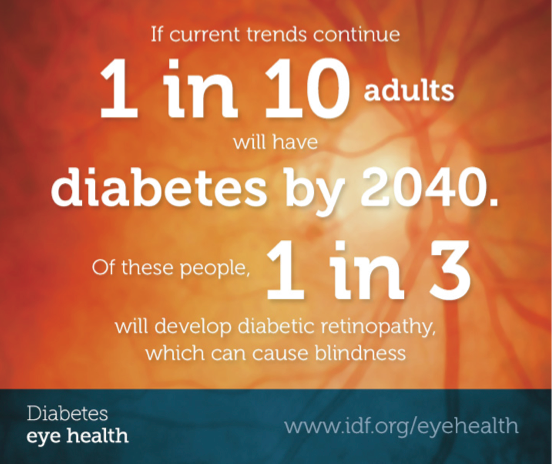What is Diabetes Eye Health: A Guide for Health Professionals?
Diabetes Eye Health: A Guide for Health Professionals (the Guide) is a practical and informative document developed for primary health professionals on managing diabetic eye disease, in particular diabetic retinopathy (commonly called DR).
The Guide aims to raise awareness among health professionals about the growing prevalence of DR, and identifies the key roles and actions health care professionals can take in prevention, screening, monitoring, and referral.
The Guide, Diabetic Eye Health: A Guide for Health Professionals, was developed in response to the growing numbers of people with diabetes, particularly in low and middle income countries. It points to the important role of health professionals in identifying and facilitating management of DR and the need for collaboration across diabetes, eye and primary health sectors.
Blindness can be largely avoided with effective diabetes management, regular eye exams, and timely treatment. Ensuring all people with diabetes have access to these important health care services will require a new approaches in service provision and cross-sectoral collaboration. With the increase in the number of people developing diabetes, it is more important than
ever that both health practitioners and patients understand that diabetic retinopathy is largely avoidable, with the right care.
A copy of the Guide can be downloaded HERE
Who developed the Guide?
The Guide is an initiative of the International Diabetes Federation (IDF) and The Fred Hollows Foundation (The Foundation). It was developed in consultation with a working group of experts from a variety of disciplines and geographical regions. The disciplines represented were:
• Ophthalmology • Diabetology • Optometry • Primary Health • Diabetes Education
Geographical regions represented were based on the regional structure of the World Health Organisation, and the seven IDF regions. They are as follows:
• Africa • Middle East and North Africa • South and Central America • Western Pacific
• Europe • North America and Caribbean • South-East Asia
Why was the Guide developed?
There are a range of clearly defined clinical guidelines for diagnosis and treatment of DR developed for eye specialists, however, there is little advice written for those providing primary health services for people with diabetes on how to screen for DR and when to refer patients for further investigation.
In addition, clinical practice guidelines for the management of DR have been implemented throughout the world, but mainly in developed nations where there is access to quality resources and appropriate referral pathways. In low resource settings, it is important to provide practical and useful advice appropriate for the context.
Diabetes Prevalence Statistics – latest IDF Atlas figures as of 14th November 2015
• 1 in 11 adults have diabetes (415 million)
• 318 million adults have impaired glucose tolerance (6.7% of adults aged 20-79)
• 46.5% of adults with diabetes are undiagnosed
• 12% of global health expenditure is spent on diabetes (USD 673 billion)
• Three-quarters (75%) of people with diabetes live in low- and middle-income countries
• There will be an estimated 4.96 million deaths from diabetes in 2015
• 1 in 7 births are affected by gestational diabetes
• 542,000 children aged under 15 have type 1 diabetes
• By 2040, 1 adult in 10 will have diabetes (642 million) and expenditure will exceed USD 802 billion
• The number of people with diabetes is increasing rapidly, particularly in low and middle income countries
• Every person with diabetes is at risk of going blind, and diabetic retinopathy is already the leading cause of blindness in working age adults.
• Over 90 million people have diabetic retinopathy, and this number will rapidly rise unless effective action is taken.
What is Diabetic Retinopathy?
Diabetic retinopathy is a complication of diabetes in which the capillaries in the retina are damaged as a result of chronic hyperglycaemia (high and varying blood sugar levels). The damaged capillaries allow leakage in to the retina, disrupting its normal function, and capillary blockage, which restricts blood flow to the retina depriving it of oxygen. This can lead to loss of vision and eventually blindness. Diabetic retinopathy is generally asymptomatic until it becomes more severe. Many people with mild diabetic retinopathy have no symptoms. In more advanced cases however, blurred vision, floaters or sudden catastrophic loss of vision can occur in one or both eyes.
How can Diabetic Retinopathy be prevented and managed?
Blindness can be largely avoided with effective diabetes management, regular eye screening, and timely treatment. Ensuring all people with diabetes have access to these important health care services requires a new approach in service provision and cross-sectoral collaboration. Primary health workers are at the frontline of providing services to people with diabetes, and this must include screening for and monitoring diabetic eye health, and timely referral to eye specialists for further examination and treatment.
The Guide offers practical information to support this new cross-sectoral and collaborative approach to managing diabetic retinopathy.

 My name is Dr. Norbert Uzabumwana, I am a first year resident at RIIO. I am Rwandan and I have been working as General practitioner working for the public hospital for 5 years before joining the residency. Some years back, my grandfather had an eye condition that ended up blinding him. Since that time his life changed forever. As I grew up looking for my future career I realized that there is nothing great compared to restoring the sight for people. Even though there is shortage of doctors in the whole country, but the field of eye health is among the most affected. The path to choosing my medical career brought me to ophthalmology.
My name is Dr. Norbert Uzabumwana, I am a first year resident at RIIO. I am Rwandan and I have been working as General practitioner working for the public hospital for 5 years before joining the residency. Some years back, my grandfather had an eye condition that ended up blinding him. Since that time his life changed forever. As I grew up looking for my future career I realized that there is nothing great compared to restoring the sight for people. Even though there is shortage of doctors in the whole country, but the field of eye health is among the most affected. The path to choosing my medical career brought me to ophthalmology. Dr. KWIZERA Jean Rene is currently a resident in the Department of Ophthalmology at RIIO-COESCA With a passion for vision health and patient care; He is dedicated to making a meaningful impact in the lives of patients through both medical and surgical interventions.
Dr. KWIZERA Jean Rene is currently a resident in the Department of Ophthalmology at RIIO-COESCA With a passion for vision health and patient care; He is dedicated to making a meaningful impact in the lives of patients through both medical and surgical interventions. My name is Gad DUSENGIMANA, and I am a medical doctor. Growing up in Rwanda, when I was a child, I witnessed many people suffering from blindness especially in rural area, they were walking through life without the care they needed. This struggle became personal when my grandfather lost his sight in both eyes. I vividly remember walking with him, holding a stick to guide him as he followed behind me. We lost hope for his vision due to the lack of access to healthcare, and it was during these moments that I realized the severe shortage of ophthalmologists in our country, where even preventable blindness was often left untreated.
My name is Gad DUSENGIMANA, and I am a medical doctor. Growing up in Rwanda, when I was a child, I witnessed many people suffering from blindness especially in rural area, they were walking through life without the care they needed. This struggle became personal when my grandfather lost his sight in both eyes. I vividly remember walking with him, holding a stick to guide him as he followed behind me. We lost hope for his vision due to the lack of access to healthcare, and it was during these moments that I realized the severe shortage of ophthalmologists in our country, where even preventable blindness was often left untreated. I am Dr. Moise ISHIMWE SEBIKARI, PGY 1 Resident at Rwanda International Institute of Ophthalmology RIIO. I chose to join ophthalmology because I found scarcity of ophthalmology in developing countries, especially here I Rwanda, yet a huge number of people with eye diseases, some of them which are totally avoidable and treatable, and I found in myself one of the answer.Since then I looked for the opportunity to help me to achieve my dreams that is when I knew RIIO, and applied for Resident in ophthalmology. Unfortunately for the first time in 2021, I did not pass well but also I had kept trying to do application because of the way I really liked ophthalmology. Later one I Applied again in 2022, I did exams and a got admission in 2023.
I am Dr. Moise ISHIMWE SEBIKARI, PGY 1 Resident at Rwanda International Institute of Ophthalmology RIIO. I chose to join ophthalmology because I found scarcity of ophthalmology in developing countries, especially here I Rwanda, yet a huge number of people with eye diseases, some of them which are totally avoidable and treatable, and I found in myself one of the answer.Since then I looked for the opportunity to help me to achieve my dreams that is when I knew RIIO, and applied for Resident in ophthalmology. Unfortunately for the first time in 2021, I did not pass well but also I had kept trying to do application because of the way I really liked ophthalmology. Later one I Applied again in 2022, I did exams and a got admission in 2023. Dr Jean de Dieu Ntivuguruzwa,In 2019, he was deployed at Butaro Hospital as an intern Medical Doctor for a period of 12 months, from where after he was deployed at Byumba Distric Hospital by Rwanda MOH as a General Practitioner (02/08/2021). Since then he started searching information on how he can find a school of Ophthalmology, after finding that there is a large gap of ophthalmologists in different hospitals (including where I was practicing).
Dr Jean de Dieu Ntivuguruzwa,In 2019, he was deployed at Butaro Hospital as an intern Medical Doctor for a period of 12 months, from where after he was deployed at Byumba Distric Hospital by Rwanda MOH as a General Practitioner (02/08/2021). Since then he started searching information on how he can find a school of Ophthalmology, after finding that there is a large gap of ophthalmologists in different hospitals (including where I was practicing). Dr ANNA Major, Emerging from the serene Caribbean Island of The Bahamas, Anna Major stands as a first-year post-graduate resident at the Rwanda International Institute of Ophthalmology (RIIO). Her fervor for ophthalmology took root during her medical school days that was sparked by a poignant encounter with a young mother grappling with the harsh reality of irreversible vision loss due to uncontrolled diabetes. As Anna embarked on her chosen career trajectory, she actively engaged in numerous ophthalmic research projects and altruistic endeavors, both as a medical student and as a practicing physician.
Dr ANNA Major, Emerging from the serene Caribbean Island of The Bahamas, Anna Major stands as a first-year post-graduate resident at the Rwanda International Institute of Ophthalmology (RIIO). Her fervor for ophthalmology took root during her medical school days that was sparked by a poignant encounter with a young mother grappling with the harsh reality of irreversible vision loss due to uncontrolled diabetes. As Anna embarked on her chosen career trajectory, she actively engaged in numerous ophthalmic research projects and altruistic endeavors, both as a medical student and as a practicing physician. In Rwanda, eye conditions are still a burden of our society. There is a gap of Ophthalmologists countrywide, existing specialists are only based in the Referral Hospitals and some private clinics. From a five year experience I had as General Practitioner in different District Hospitals of Rwanda, I realized that my undergraduate background in Ophthalmology is not sufficient to serve patients with eye problems, and for this reason, I have joined Ophthalmology residency at RIIO school of Ophthalmology where I am now gaining more experiences from different experts all over the World, clinical skills that are parallel to the surgical skills through wet labs where special instruments are used enhance our learning quality.
In Rwanda, eye conditions are still a burden of our society. There is a gap of Ophthalmologists countrywide, existing specialists are only based in the Referral Hospitals and some private clinics. From a five year experience I had as General Practitioner in different District Hospitals of Rwanda, I realized that my undergraduate background in Ophthalmology is not sufficient to serve patients with eye problems, and for this reason, I have joined Ophthalmology residency at RIIO school of Ophthalmology where I am now gaining more experiences from different experts all over the World, clinical skills that are parallel to the surgical skills through wet labs where special instruments are used enhance our learning quality. My first 30 days at Rwanda International Institute of Ophthalmology were full of new experiences of learning. Before joining RIIO, I spent more than 18 years in school, from nursery, primary, high school as well as undergraduate medical school, all of which were almost similar in learning and teaching methods. After medical school, I realized I had some deficiency in ophthalmology knowledge, and I embarked on the way of learning some principles in that strange field, which landed me in RIIO as a resident.
My first 30 days at Rwanda International Institute of Ophthalmology were full of new experiences of learning. Before joining RIIO, I spent more than 18 years in school, from nursery, primary, high school as well as undergraduate medical school, all of which were almost similar in learning and teaching methods. After medical school, I realized I had some deficiency in ophthalmology knowledge, and I embarked on the way of learning some principles in that strange field, which landed me in RIIO as a resident. In pursuit of purpose, I ended up in the Rwanda International Institute of Ophthalmology to begin my dream career. This was the first time I was leaving my country for a foreign land. Like Abraham of old, it felt like leaving the known for the unknown & uncertain. Nevertheless, I didn’t hesitate to heed the call. This past (almost) two months have been wonderful. I especially like the learning style, the paperless approach to doing most things & the friendly staff that make my time here all the more bearable & worthwhile. I have definitely grown and look forward to more exciting times of learning & GROWTH.
In pursuit of purpose, I ended up in the Rwanda International Institute of Ophthalmology to begin my dream career. This was the first time I was leaving my country for a foreign land. Like Abraham of old, it felt like leaving the known for the unknown & uncertain. Nevertheless, I didn’t hesitate to heed the call. This past (almost) two months have been wonderful. I especially like the learning style, the paperless approach to doing most things & the friendly staff that make my time here all the more bearable & worthwhile. I have definitely grown and look forward to more exciting times of learning & GROWTH. As a young man growing up in the village, I watched my grandmother grow progressively blind from what I later came to learn was cataracts. She became suicidal and her life came to a halt. For those who grow up in the village you know the role of a grandmother to the community, she was the one left to care for the domestic animals, raise all the kids while everyone went out to work, made sure we the kids were fed and cared for amongst many other roles within the homestead. So with her blindness, her roles stopped and the family was slowly disintegrating.
As a young man growing up in the village, I watched my grandmother grow progressively blind from what I later came to learn was cataracts. She became suicidal and her life came to a halt. For those who grow up in the village you know the role of a grandmother to the community, she was the one left to care for the domestic animals, raise all the kids while everyone went out to work, made sure we the kids were fed and cared for amongst many other roles within the homestead. So with her blindness, her roles stopped and the family was slowly disintegrating. I am Dr. IMANIRIHO Jean Damascene, an RIIO resident working to become an ophthalmologist. I have been working as a general practitioner in Rwandan public and private hospitals, located in rural and urban regions, for four years before joining RIIO. I am driven by helping people in need. After being treated for an ocular condition while doing my first year of medical school, I remarked how vision impacts people’s lives and decided to become an ophthalmologist. For me, vision is equivalent to live.
I am Dr. IMANIRIHO Jean Damascene, an RIIO resident working to become an ophthalmologist. I have been working as a general practitioner in Rwandan public and private hospitals, located in rural and urban regions, for four years before joining RIIO. I am driven by helping people in need. After being treated for an ocular condition while doing my first year of medical school, I remarked how vision impacts people’s lives and decided to become an ophthalmologist. For me, vision is equivalent to live. I am Elie, a Rwandan medical doctor. I have been observing the burden of blindness specifically avoidable blindness across the world but mostly in the developing world and found that blindness and eye care, in general, are still marginalized hence they are among the most devastating conditions for health. So, I thought about bringing my contribution to this noble cause. As Mandela said, “education is the only weapon we can use to change the world” for me too, ophthalmology education was the only weapon I could use to beat blindness as well as take eye care to the next level; so I joined RIIO to fully prepare myself to this; RIIO is not only the home institution but also I consider their expertise in the field of ophthalmology as an added value to fulfilling my objectives.
I am Elie, a Rwandan medical doctor. I have been observing the burden of blindness specifically avoidable blindness across the world but mostly in the developing world and found that blindness and eye care, in general, are still marginalized hence they are among the most devastating conditions for health. So, I thought about bringing my contribution to this noble cause. As Mandela said, “education is the only weapon we can use to change the world” for me too, ophthalmology education was the only weapon I could use to beat blindness as well as take eye care to the next level; so I joined RIIO to fully prepare myself to this; RIIO is not only the home institution but also I consider their expertise in the field of ophthalmology as an added value to fulfilling my objectives. I am Dr. Gilbert NSHIMIYIMANA.I am one of those who think that one of the greatest gifts that God gave man is “SIGHT”.I strive to provide and maintain quality eye care services and that has always been my dream. Rwanda is one of the developing countries suffering from blindness specifically avoidable blindness due to many factors, one of them being few trained eye care specialists (ophthalmologists). By Joining RIIO, my dream did not only come true but also I strongly believe it will enable us to take quality eye health solutions to the next better level.
I am Dr. Gilbert NSHIMIYIMANA.I am one of those who think that one of the greatest gifts that God gave man is “SIGHT”.I strive to provide and maintain quality eye care services and that has always been my dream. Rwanda is one of the developing countries suffering from blindness specifically avoidable blindness due to many factors, one of them being few trained eye care specialists (ophthalmologists). By Joining RIIO, my dream did not only come true but also I strongly believe it will enable us to take quality eye health solutions to the next better level. My name is David NGABO, Medical doctor, First Year Ophthalmology resident at RIIO. It has always been a dream of mine to be a solution orientated person, through that I always think about how I can contribute to the community. Finally, I realized that my passion is to help improve health by helping people with disabilities especially blindness to improve their quality of life. Joining the ophthalmology residency program at Rwanda International Institute of Ophthalmology(RIIO) is an opportunity for me due to the fact that RIIO has a dedicated team with different expertise and is ready to train young professionals. I believe that through this perspective, I will become a promising ophthalmologist, ready to provide a tremendous contribution to my country and in the region, especially in strengthening eye health care, education, and Research.
My name is David NGABO, Medical doctor, First Year Ophthalmology resident at RIIO. It has always been a dream of mine to be a solution orientated person, through that I always think about how I can contribute to the community. Finally, I realized that my passion is to help improve health by helping people with disabilities especially blindness to improve their quality of life. Joining the ophthalmology residency program at Rwanda International Institute of Ophthalmology(RIIO) is an opportunity for me due to the fact that RIIO has a dedicated team with different expertise and is ready to train young professionals. I believe that through this perspective, I will become a promising ophthalmologist, ready to provide a tremendous contribution to my country and in the region, especially in strengthening eye health care, education, and Research. My name is Eric MANIRAKIZA. I’m a Burundian Medical doctor and First-Year Ophthalmology resident at RIIO. After completing my studies at Hope Africa University in Burundi, I got a chance to work at VAN NORMAN clinic, which is the Clinic run by the same University where I got the opportunity to practice my medical career. After 3 years of practice, I got a great opportunity to be admitted to the Ophthalmology Residency Program at Rwanda International Institute of Ophthalmology (RIIO) which is the most accurate Institution in the region concerning its good purpose and values. I believe that through the education and training provided by RIIO, I will be among the future successful generation of ophthalmologists produced by RIIO, who are ready to give their contribution to their different countries and the region in general, especially in preventing avoidable blindness in the population of Africa.
My name is Eric MANIRAKIZA. I’m a Burundian Medical doctor and First-Year Ophthalmology resident at RIIO. After completing my studies at Hope Africa University in Burundi, I got a chance to work at VAN NORMAN clinic, which is the Clinic run by the same University where I got the opportunity to practice my medical career. After 3 years of practice, I got a great opportunity to be admitted to the Ophthalmology Residency Program at Rwanda International Institute of Ophthalmology (RIIO) which is the most accurate Institution in the region concerning its good purpose and values. I believe that through the education and training provided by RIIO, I will be among the future successful generation of ophthalmologists produced by RIIO, who are ready to give their contribution to their different countries and the region in general, especially in preventing avoidable blindness in the population of Africa. Je suis Dr KAVIRA MALIRO Valence, de nationalité Congolaise. Je suis née à Goma ou j’ai grandi, puis fait mes études en Médecine à l’université catholique de Bukavu(UCB). J’ai ensuite travaillé dans un projet belgo congolais dénomméAFIA SHULENI, ayant pour objectif d’améliorer les résultats scolairesdes enfants en leur assurant une bonne santé.Pendant ce temps, nous avons constaté que bon nombre d’enfants ne bénéficient pas de la consultation pré- scolaire avant de commencer l’école maternelle voir même primaire. J’ai fait partie de l’équipe chargée d’examinerdes enfants dans différentes écoles pour détecter des pathologies inconnues ou ignorées par les parents. Nous avons rencontré plusieurs problèmes.
Je suis Dr KAVIRA MALIRO Valence, de nationalité Congolaise. Je suis née à Goma ou j’ai grandi, puis fait mes études en Médecine à l’université catholique de Bukavu(UCB). J’ai ensuite travaillé dans un projet belgo congolais dénomméAFIA SHULENI, ayant pour objectif d’améliorer les résultats scolairesdes enfants en leur assurant une bonne santé.Pendant ce temps, nous avons constaté que bon nombre d’enfants ne bénéficient pas de la consultation pré- scolaire avant de commencer l’école maternelle voir même primaire. J’ai fait partie de l’équipe chargée d’examinerdes enfants dans différentes écoles pour détecter des pathologies inconnues ou ignorées par les parents. Nous avons rencontré plusieurs problèmes.